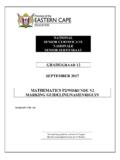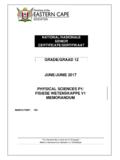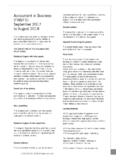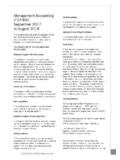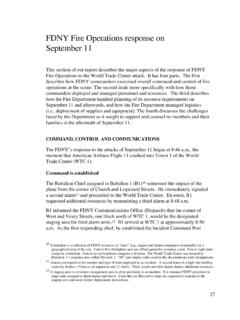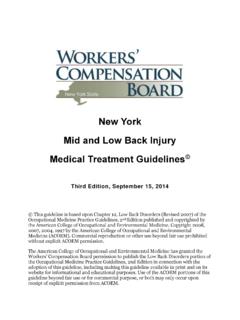Transcription of GRADE 12 SEPTEMBER 2017 ENGLISH HOME …
1 NATIONAL. SENIOR CERTIFICATE. GRADE 12. SEPTEMBER 2017. ENGLISH HOME LANGUAGE P1. MARKS: 70. TIME: 2 hours This question paper consists of 14 pages. 2 ENGLISH HOME LANGUAGE P1 (EC/ SEPTEMBER 2017). INSTRUCTIONS AND INFORMATION. 1. This question paper consists of THREE sections: SECTION A: Comprehension (30). SECTION B: Summary (10). SECTION C: Language Structures and Conventions (30). 2. Read ALL the instructions carefully. 3. Answer ALL the questions. 4. Start EACH section on a NEW page. 5. Rule off after each section. 6. Number the answers correctly according to the numbering system used in this question paper. 7. Leave a line after each answer.
2 8. Pay special attention to spelling and sentence construction. 9. Suggested time allocation: SECTION A: 50 minutes SECTION B: 30 minutes SECTION C: 40 minutes 10. Write neatly and legibly. Copyright reserved Please turn over (EC/ SEPTEMBER 2017) ENGLISH HOME LANGUAGE P1 3. SECTION A: COMPREHENSION. QUESTION 1: READING FOR MEANING AND UNDERSTANDING. Read TEXTS A and B and answer the questions set. TEXT A. MASS MEDIA BRAINWASHING. 1 Propaganda must always be essentially simple and repetitious. The most brilliant propagandist technique will yield no success unless one fundamental principle is borne in mind constantly it must confine itself to a few points and repeat them over and over.
3 Joseph Goebbels, Nazi Propaganda Minister 5. 2 How fortunate for governments that the people they administer don't think. Adolf Hitler 3 Take it from Goebbels and Hitler, true experts on mass-brainwashing. And the government, particularly the CIA, has learned a great deal from the Nazis. The Nazis in turn learned a great deal from American corporate 10. advertising techniques and the American mass-media. The American corporate mass-media is the world's greatest practitioner of what its student Goebbels preached: repeating simple-minded lies over and over for months and years, until the lies take on a life of their own and all the American sheeple repeat them unthinkingly as commonly accepted facts.
4 15. 4 The fact is that mass media, especially through television, is a source of brainwashing. A researcher named Herbert Krugman, who later became manager of public-opinion research at General Electric, decided to try to discover what goes on physiologically in the brain of a person watching TV. He chose a subject and taped an electrode to the back of her head which 20. was connected to a computer. 5 Krugman began monitoring the brain-waves of the subject. What he found through repeated trials was that within about thirty seconds, the brain-waves switched from predominantly beta waves, indicating alert and conscious attention, to predominantly alpha waves, indicating an unfocused, receptive 25.
5 Lack of attention: the state of aimless fantasy and daydreaming below the threshold of consciousness. When Krugman's subject turned to reading through a magazine, beta waves reappeared, indicating that conscious and alert attentiveness had replaced the daydreaming state. 6 What surprised Krugman, who had set out to test the effect of TV-viewing 30. on the mind, was how rapidly the alpha-state emerged. Further research revealed that the brain's left hemisphere, which processes information logically and analytically, tunes out while the person is watching TV. This tuning-out allows the right hemisphere of the brain, which processes information emotionally and noncritically, to function unimpeded.
6 It appears, 35. wrote Krugman, that the mode of response to television is more or less constant and very different from the response to print. That is, the basic electrical response of the brain is clearly related to the medium. Copyright reserved Please turn over 4 ENGLISH HOME LANGUAGE P1 (EC/ SEPTEMBER 2017). Watching television encourages noncritical thinking while reading encourages critical thinking. 40. 7 The key phrase in Krugman's findings was that TV transmits information not thought about at the time of exposure. Later, however, when we encounter a real-life situation, a wealth of associations is triggered. A person's recall of this information is evoked by the person or product itself, interacting with the stored data in their brain.
7 45. 8 As real-life experience is increasingly replaced by the mediated experience , it becomes easy for politicians and market-researchers of all sorts to rely on a base of mediated mass experience that can be evoked by appropriate triggers. The TV world becomes a self-fulfilling prophecy: the mass mind takes shape, its participants acting according to media-derived impulses and 50. believing them to be their own personal volition arising out of their own desires and needs. In such a situation, whoever controls the screen controls the future, the past, and the present. 9 The following statistics and research come from a television show called TV.
8 And its impact on society and our kids hosted by Dennis McCuistion featuring 55. Sonja Ezell, a reading specialist and Hank Moore, a corporate strategist. 60% of the American population and 50% of corporate America is functionally illiterate 2 5 year olds spend 32 hours watching TV. 6 11 year olds spend 28 hours watching TV 60. 68% of children have a TV in their bedrooms watching 1,5 hours more TV than those who don't 37% have cable access 4 year olds watching the daily average (3,5 hours) were 25% more likely to become bullies 65. pre-schoolers who watch television violence, and play violent video games show much higher levels of aggression and antisocial behaviour than those not exposed.
9 A study of more than 700 families found that 14-year-old boys who watched relatively more television were more likely to have assaulted 70. someone or committed a serious act of aggression by the time they were 22 years old. there is a direct correlation between a child's weight and the number of hours the child spends watching television. the number of sexual incidents that occur during prime time (7 9) has 75. increased fourfold during the last 20 years. nearly three out of four 15 17 year olds (72%) believe that sexual content on TV influences the behaviour of kids their age. [Adapted from and ]. AND. Copyright reserved Please turn over (EC/ SEPTEMBER 2017) ENGLISH HOME LANGUAGE P1 5.
10 TEXT B. B1. B2. [Adapted from ]. Copyright reserved Please turn over 6 ENGLISH HOME LANGUAGE P1 (EC/ SEPTEMBER 2017). QUESTIONS TEXT A. Explain what you understand under the title: Mass Media Brainwashing . (2). What is the significance of the inclusion of the quotes by Goebbels and Hitler? (2). What do you think the Nazis could have learned from American corporate advertising techniques? (Paragraph 3) (2). Refer to the word sheeple in Paragraph 3. Comment on the use of the word here. (2). What tone is conveyed by this word? (1). Indicate which type of brainwave will be observed when the following actions take place: Write only the words alpha or beta next to the number.

